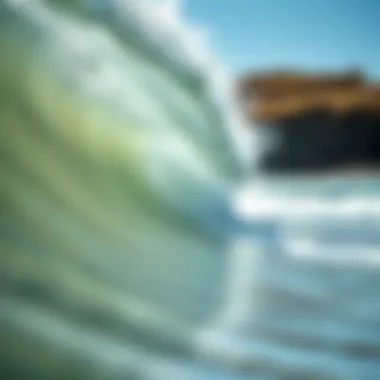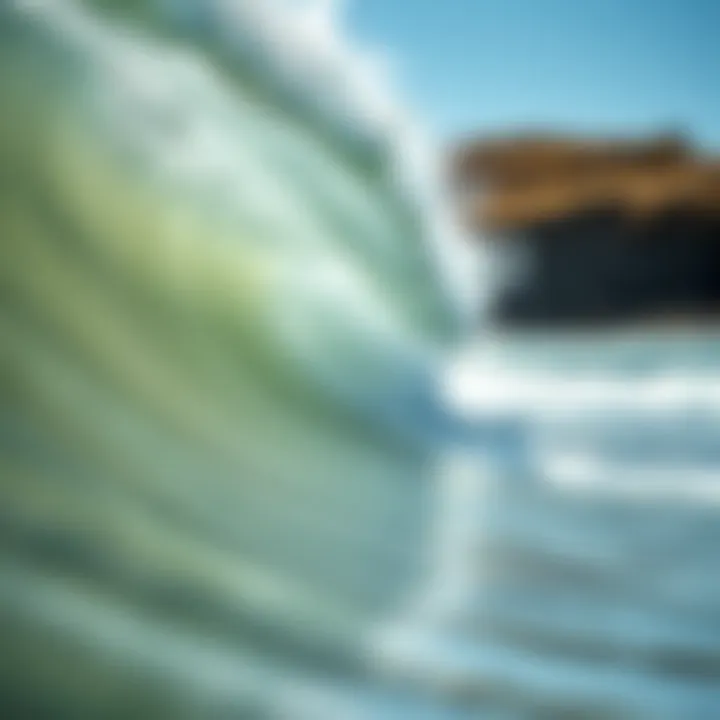Techniques for Effective Wax Removal from Surfaces


Intro
Removing wax from various surfaces, especially for surfboard enthusiasts, often seems daunting. Wax buildup can inhibit performance and affect the longevity of your equipment. As surfers, you may know that a clean board not only enhances your glide through the water but also ensures better adhesion during wax application. This article sets out a detailed guide focusing on effective methods tailored specifically to surfers. What follows will explore techniques broken down by surface types and wax characteristics, alongside essential tools required for optimal maintenance.
From learning how to tackle stubborn wax on fiberglass to managing residue on more delicate materials, the techniques discussed here are designed to empower you. Whether you're just starting or have surfed for years, mastering the removal of wax is key to preserving your gear and enhancing your overall surfing experience.
Surfing Techniques
While the primary focus here is on the removal of wax, understanding the impact of a clean board on surfing techniques is crucial. A well-maintained board can enhance both performance and safety on the waves.
Advanced Maneuvers for Experienced Surfers
For the seasoned surfer, having a board that's free of unnecessary wax not only boosts speed but also allows for precision in executing advanced maneuvers. Techniques like the cutback, where you sharply turn back towards the wave, greatly benefit from a clean surface, enabling smoother transitions. A sticky surface might feel secure, but too much wax can create resistance, hindering your performance. Take heed of how your board behaves and adjust the wax layer accordingly.
Beginner Tips for Catching Your First Wave
For newcomers, less is often more. A new surfer should focus on applying just enough wax for grip. Overdoing it can lead to unnecessary complications. Start with a base coat and a top coat, learning to appreciate how less wax can improve stability while paddling out. When you're ready to remove old wax, keeping your board in top shape can significantly enhance your learning curve.
Wax Removal Techniques
Different surfaces demand various removal strategies, tailored to the type of wax in play.
Fiberglass Surfboard Wax Removal
Fiberglass boards are the most common type used by surfers. To remove wax from these, consider these methods:
- Heat Gun Method: Carefully warm the surface using a heat gun. This will soften the wax, making it easier to scrape off with a plastic scraper. Be cautious not to overheat, as it could damage the board.
- Stainless Steel Scraper: For stubborn spots, a stainless steel scraper can provide the necessary leverage. However, use with care to avoid scratching the board.
- Cleaning Agents: Following up with a gentle cleaner specifically designed for surfboards can finish the job and restore the shine.
Soft Top Surfboard Techniques
Soft top surfboards require a gentler touch. Here are some options:
- Hot Water Approach: Dip a soft cloth into hot water and apply it to the wax. This warmth will help dissolve the wax without damaging the soft top material.
- Plastic Scraper: Using a plastic scraper, gently lift away the softened wax, ensuring you’re not too aggressive to prevent tearing the surface.
"Investing time in cleaning your surfboard can yield significant rewards during your sessions. A clean board truly helps rider performance."
Tools You Will Need
To tackle the task effectively, here’s a quick list of essential tools:
- Plastic scrapers or credit cards
- Stainless steel scrapers for stubborn wax
- Heat gun or hairdryer
- Cleaning cloths
- Gentle surfboard cleaner
- Bucket of hot water
- Soft brush (for soft tops)
In summary, maintaining your surfboard through effective wax removal techniques is not just about aesthetics. It has a direct effect on your surfing experience, especially as conditions change. By applying these methods and knowing when to remove or add wax, you set yourself up for success on the waves.
Understanding Wax Removal
When it comes to maintaining surfboards or other surfaces that commonly encounter wax, understanding the methods for wax removal is crucial. Wax serves its purpose by providing water resistance and a better grip while navigating waves. However, over time, a build-up of wax can hinder performance and lead to surface degradation. Proper wax removal ensures not only a cleaner surface but also enhances the durability of the gear.
The Importance of Wax Maintenance
Maintaining the proper condition of waxed surfaces goes beyond aesthetics. Regularly removing and reapplying wax helps preserve the materials underneath. For surfboards, excessive wax can trap dirt, sand, and moisture, creating conditions ripe for corrosion or deterioration. Familiarizing oneself with effective maintenance strategies promotes a longer lifespan for your board and improves your overall surfing experience.
Additionally, wax affects the board’s handling and maneuverability. Surfers often prefer a certain type of wax depending on the water temperature; a build-up can lead to unwanted stickiness that detracts from performance. Thus, keeping wax in check plays a significant role in ensuring your board responds predictably under varying conditions.
Types of Wax Commonly Used
Not all wax is created equal, particularly in the world of surfing. Understanding the different types of wax can guide users in their maintenance choices. Here are the major categories to consider:
- Basecoat Wax: Generally used as the initial layer, it creates a solid foundation for upper layers of wax. Knowing how to apply it properly can lead to improved adhesion and performance.
- Topcoat Wax: This is what many surfers apply over the basecoat. It offers the level of grip that suits various surfing styles, allowing users to find their ideal balance between stickiness and ease of movement.
- Specialty Wax: Some brands produce waxes designed for specific conditions, like those better suited for colder climates or those infused with additives for various reasons, like UV protection.
Being aware of the different wax types enables better decision-making in the maintenance process, ensuring that the most appropriate product is used for optimal results. Consequently, proper understanding leads to a more effective application and removal process, thus safeguarding the quality of your equipment and keeping your surfing adventures enjoyable.


Preparation for Wax Removal
Preparation is the cornerstone of effective wax removal. Before diving in with tools and methods, it's crucial to lay down some foundational work. By taking the time to prep, one can enhance the entire process—making it less messy and more efficient. Proper planning allows for a smoother experience, reducing the likelihood of mishaps or damage to the surfaces you’re working with. So, let’s roll up our sleeves and get into what you need to do before you start removing that wax.
Gathering Essential Tools
Having the right tools at your disposal can make all the difference when it comes to removing wax. Let’s break down what you need and why:
- Heat Source: An essential item, a heat gun or a hairdryer can effectively melt wax, making it easier to wipe away. Make sure you choose a device that allows you to control the heat setting.
- Scraper: Whether it's a plastic spatula, an old credit card, or a dedicated wax scraper, the key is to choose a tool that won't damage the surfaces.
- Cloths: A few clean cloths—preferably microfiber—are beneficial for wiping away melted wax and applying solvents if necessary.
- Solvents: Depending on the surface, you might need a suitable solvent like rubbing alcohol or a specialized wax remover. Always keep in mind the material you’re working with to avoid any adverse reactions.
- Protective Gear: Depending on the situation, gloves and goggles are recommended, especially when using heat and chemicals. Safety first!
By gathering these tools ahead of time, you set yourself up for success. Nothing worse than realizing you forgot a key item halfway through the process!
Assessing the Surface Type
Every surface reacts differently to wax removal attempts. Knowing what you're dealing with is half the battle. Assessing the type of surface will determine your approach, saving you time and preventing potential damage.
- Surfboards: Typically, surfboards have a glossy finish. This means they require a gentler touch to maintain integrity while removing wax. Check for any damage beforehand; a stressed spot might make it prone to chipping or breaking.
- Fabrics: When dealing with clothing or upholstery, it’s vital to know the fabric type. Delicate fabrics like silk or wool need a softer approach, whereas cotton can handle a bit more action.
- Furniture: If you're tackling furniture, the finish is key. A wooden table might have varnish or oil that can be affected negatively. Look for any labels or care instructions to guide your techniques.
- Carpets: Carpet fibers can be tricky, too. An initial vacuuming is a good start to clear off any loose debris before applying heat or solvents.
Understanding these surfaces and their unique characteristics can help avoid nightmares down the road.
"Preparation is the key to success," as they say. Knowing what you're up against can transform an overwhelming task into a systematic process. Get ready, because an organized effort leads to fantastic results.
Removal Techniques for Surfboards
When it comes to keeping your surfboard in top-notch condition, knowing the best methods for wax removal is imperative. Wax builds up over time, affecting performance and leaving a less-than-ideal surface for your next ride. Effective removal techniques not only ensure your board glides smoothly but also enhance its longevity, making this topic especially relevant for surfboarding enthusiasts.
Using Heat to Remove Wax
Heat is one of the go-to methods for tackling wax residue, and for good reason. When applied correctly, it helps soften the wax, making it easier to wipe away without damaging the surfboard’s surface. Here’s how to utilize heat effectively:
Selecting the Right Heat Source
Selecting a suitable heat source is critical in this process. Common options include hair dryers, heat guns, or even sunlight. Hair dryers are gentle and won’t typically overheat the board, which makes them a popular choice among many surfers. A heat gun, on the other hand, is more powerful but requires a steadier hand to avoid overheating the board.
What makes the hair dryer stand out is its balance between heat output and safety. It heats wax evenly without the risk of scorching the surfboard’s surface. However, if you opt for a heat gun, it's beneficial for broader areas but demands more careful handling.
Applying Heat Safely
When applying heat, safety should be foremost in your mind. Always maintain a safe distance between the heat source and the surfboard, typically around six inches, to prevent any accidental damage. Move the heat source around, ensuring even distribution to avoid hot spots.
The key characteristic here is consistency. A steady motion prevents any overheating. This technique makes it a favorable option for many as it minimizes potential damage while ensuring that wax melts uniformly. Being vigilant pays off; one wrong move can ruin your board’s finish.
Monitoring Wax Melting Process
Monitoring the melting process of the wax is vital. This involves keeping an eye on the wax’s consistency as it melts; it should become gooey but not liquid. Too much heat can actually change the wax composition, making it stickier and harder to remove later.
This characteristic enables precise control over the removal process. Knowing when to stop heating can save both time and hassle. You’ll be able to tell it’s time to stop when the wax starts to shimmer and soften. After that, it's a straightforward task to wipe or scrape it off.
Scraping Off Wax Residue
Once the wax is adequately softened, the next step is scraping it off. This technique complements the use of heat efficiently and can yield excellent results.
Choosing the Right Scraper
The choice of scraper can make or break your removal process. Specialized wax scrapers made of plastic are often preferred as they’re designed specifically for this task. They’re firm enough to lift the wax while being soft on the board, preventing scratches.
The key characteristic of using the right scraper is its effectiveness. A plastic scraper adapts well to varying surface contours, ensuring that all wax is lifted without damaging the surfboard. Opting for makeshift items like metal scrapers can lead to unwanted nicks or scratches.
Techniques for Effective Scraping
To effectively scrape, angle your tool lightly – about 30 degrees – to the surface. Start from one end and work your way across, applying even pressure. This method not only aids in wax removal but also protects the board.
This technique’s unique feature is in its precision; when executed correctly, it ensures all unwanted residue is captured, leaving a clean surface behind. Take your time; a steady hand means a better finish.


Cleaning Up with Solvents
After scraping, a thorough clean-up is necessary to deal with any leftover wax spots. This step also helps in maintaining the board’s overall integrity.
Identifying Suitable Solvents
Choosing the right solvents is essential. Common options include isopropyl alcohol and specialized surfboard cleaners. Isopropyl alcohol is effective and generally easy to obtain. Being gentle, it won’t harm most surfboard surfaces.
A key characteristic here is effectiveness without aggressiveness. You want a solvent that will cut through residual wax while being safe for the surfboard material. The beauty of surfboard-specific solvents is they’re formulated to be particularly gentle while effective.
Application Techniques
When applying the solvent, use a clean cloth or sponge to dab the area. Avoid soaking the surfboard; a light application goes a long way. The unique feature of this technique is that it’s adaptable, allowing you to control how much solvent you use.
Overusing solvents can lead to a sticky surface, which you definitely want to avoid. A little goes a long way here, but ensuring the area is well-wiped after application guarantees a clean finish.
Post-Cleaning Care
Post-cleaning care ensures that the surfboard is well-maintained after wax removal. Applying some sort of conditioner or polish can help protect the surface. This step creates a barrier against future dirt and grime buildup, prolonging the time until your next wax removal session.
A critical characteristic of post-cleaning care is its preventative nature. You’re not just removing the wax but also safeguarding the surfboard for future rides. This care allows you to enjoy the surfboard for longer, making it well worth your while.
Wax Removal for Other Surfaces
Wax removal extends beyond just surfboards; it is essential for maintaining various surfaces that may encounter wax residues. This is particularly important for clothing, furniture, and carpeting. Each of these surfaces presents unique challenges and requires specific techniques for effective cleaning. Understanding how to tackle these challenges can save time, improve the lifespan of materials, and preserve aesthetics.
Tips for Removing Wax from Clothing
Testing Fabric for Damage
Before launching into any wax removal process on clothing, it's wise to test the fabric for damage. This step is crucial because some fabrics can be sensitive to heat, solvents, or scraping methods. By assessing the fabric's integrity—checking for shrinkage or colorfastness—before applying any removal techniques, you can avoid inadvertently ruining a beloved piece of clothing. This cautious approach is particularly beneficial for high-end materials such as silk or wool, which can be more delicate.
To test for damage, simply choose a discreet area on the fabric and apply a small amount of the cleaning method you plan to use, such as heat or solvent. If the area shows no signs of damage after a few minutes, you can proceed confidently. This initial step helps in avoiding disasters down the line.
Heat Application on Fabrics
Heat application is a favored method for removing wax from clothing due to its simplicity and effectiveness. When the wax is warmed, it becomes malleable and easier to lift. You can use a household iron, set on a low heat, to gently melt the wax. Place a piece of paper towel or a cloth over the wax to absorb it as it liquefies. It's a straightforward method that allows for quick results.
However, it’s vital to control the temperature. Too much heat can scorch the fabric or cause it to warp. This makes the heat application a double-edged sword: it’s efficient when used correctly but can lead to damage if it goes wrong. Hence, constant monitoring during the process is advisable.
Strategies for Furniture and Carpets
Using Ice to Harden Wax
When it comes to furniture and carpets, one effective strategy is using ice to harden the wax. This method is particularly useful for larger spills and allows you to chip away at the wax without the mess that can come from other cleanup techniques. By applying ice in a plastic bag directly on the wax, you solidify it, making it easier to scrape off using a dull knife or scraper.
This method is useful because it minimizes the risk of spreading the wax further into the fabric or surface. It’s a clean and straightforward method that requires nothing more than ice and a scraper, making it accessible to anyone without specialized tools.
Blotting Techniques with Towels
Blotting is another valuable technique for furniture and carpets, especially after utilizing ice. Once the wax has hardened and been chipped away, residual wax may remain. A blotting technique using clean towels can help lift this wax without pushing it deeper into the fabric. The process involves placing the towel over the remaining wax, followed by lightly pressing it with a warm iron.
This method’s strength lies in its ability to efficiently absorb wax without excessive scrubbing, which can damage the fibers of carpet or upholstery. It's a gentle approach that’s both effective and user-friendly.
"Patience is the key when it comes to wax removal. Each surface demands its own strategy for success."
By applying these methods thoughtfully and in consideration of the surface type, the damage can be minimized, and the aesthetic appeal of furniture and clothing can be preserved.
Post-Removal Maintenance
Maintaining your surfboard post-wax removal is crucial for prolonging its lifespan and ensuring peak performance during your next ride. After putting in the effort to get rid of the pesky wax, neglecting this phase could lead to further accumulation of debris or, worse, damage to the surfboard itself. Understanding the importance of this maintenance phase is essential for anyone who truly values their equipment.


Cleaning and Conditioning Surfaces
Having successfully removed the wax, the next step is cleaning and conditioning the surfaces of your surfboard. This action not only gives your board a fresh look but also ensures that it retains its optimal performance. Start by using a gentle, surf-friendly cleaner that won’t harm the fiberglass or foam. Spray the cleaner onto the surface and wipe it down with a soft cloth. Aim for a thorough cleanse—getting into all nooks and crannies, especially around the fins and tail.
Conditioning comes in right after cleaning. This involves applying a surfboard conditioner or wax specifically formulated to rejuvenate the material. Using a product like 3M's Marine Restorer can bring back that glossy shine. Just a small dab is enough; rub it in a circular motion—think of polishing a prized possession. You’ll notice the difference as the board starts to gleam. Regular cleaning and conditioning keeps your surfboard not just looking good, but also resistant to environmental factors like UV damage and saltwater corrosion.
Reapplying Wax Correctly
Now that the wax is off and the board gleams, it’s time to reapply wax properly. Doing this correctly enhances grip and makes each ride smoother. But how do you ensure it's done right?
Begin by selecting the right type of wax for your surf conditions. Cooler waters require a harder wax, whereas warmer waters call for softer formulations. Once you’ve got the right wax, warm it slightly between your palms before applying. This makes it easier to spread evenly across the board. Put a small amount on the edge of the board and work it in a circular pattern—covering all necessary areas adequately. Emphasizing the rail and tail regions will ensure better grip during turns and take-offs.
Once the first layer is down, allow it to cure for a bit, then add a second layer if you feel like your board could use the extra grip, particularly for more aggressive surfing styles.
"A well-waxed surfboard performs like a dream; don’t underestimate the importance of the small stuff."
Successful post-removal maintenance revolves around these simple yet effective practices. Clean your board frequently and reapply wax as per your surroundings, ensuring that you stay ahead of any potential performance issues. For more tips and further reading on surfboard maintenance, sites like Surfline and Surfer Magazine offer valuable resources. Stay informed, and your surfboard will thank you with many smooth rides ahead.
Common Mistakes to Avoid
Removing wax might seem straightforward, but there are pitfalls that can complicate the process. Understanding these common blunders can save time, effort, and potential damage to your surfaces. This section sheds light on two major mistakes to be aware of when tackling wax removal. They often lead to frustrating or ineffective results.
Using Incorrect Tools
Many people underestimate the significance of having the right tools for the job. Using the incorrect tools can lead to several issues, including damaging the surface or leaving residual wax behind.
When it comes to wax removal, your choice of scraper or heat source is critical. For instance, using a metal scraper on a delicate surfboard can scratch the surface and ruin the finish. Instead, opt for plastic scrapers that are gentler on the material. Likewise, a common error involves utilizing a heat source that's too powerful, like a blowtorch. This can create an uneven melting of wax, resulting in a sticky mess rather than clean removal.
Ensure you have the following tools at hand:
- Plastic scraper
- Heat gun or hair dryer
- Absorbent cloths
- Suitable solvents such as mineral spirits or rubbing alcohol
"Using the right tools is half the battle won."
The wrong choices not only make the process longer but can also lead to expensive repairs or replacements. Before starting, take a moment to gather appropriate tools to enhance your removal technique.
Rushing the Process
In our fast-paced lives, it’s tempting to rush through tasks, including wax removal. However, hurrying can lead to mistakes that many surfboard enthusiasts have learned the hard way.
Wax removal is not just about scraping and cleaning; it's a careful procedure that involves understanding the surface and methodical application of heat. If you rush it, you risk uneven removal or failing to notice areas that need more attention. When the wax is melted, give it time to set before scraping. Often, letting heat penetrate fully ensures that the wax comes off without too much elbow grease.
Here are a few pointers to avoid rushing through this process:
- Allocate sufficient time for each step.
- Allow the heat to work before attempting to scrape off wax.
- Be patient with solvent application; let it sit for a bit to break down the wax before wiping it away.
Taking a measured approach can make a world of difference. Instead of viewing wax removal as a chore to finish quickly, consider it as a part of your maintenance routine, helping prolong the life of your gear.
By steering clear of incorrect tools and allowing yourself adequate time, you will avoid common pitfalls in your wax removal venture, leading to a smoother and more successful experience.
Culmination
In wrapping up this comprehensive guide, it's crucial to emphasize how effective wax removal not only enhances the aesthetic appeal of surfboards and other surfaces but also significantly prolongs their lifespan. The proper techniques discussed here ensure that wax residue does not accumulate over time, which can lead to a variety of issues including loss of grip, reduced performance on the water, and even surface damage in extreme cases. By following these guidelines, anyone can maintain their gear with relative ease, ensuring that they’re always ready to hit the waves.
Summary of Key Steps
To effectively summarize the essential points discussed throughout the article:
- Preparation is Essential: Before starting any removal, gather your tools and be aware of the surface type.
- Utilize Heat Wisely: Applying heat in a controlled manner can significantly ease the wax removal process.
- Scraping Technique Matters: Choosing the right tool for scraping can make or break your effort; whether using specialized scrapers or common household utensils, ensure they suit your needs.
- Post-Cleaning Care is Key: After removing wax, cleaning the surface and properly applying wax again prolongs the usability of your gear.
By adhering to these key steps, you can mitigate the chances of making common mistakes and ensure a seamless maintenance routine.
Encouragement for Routine Maintenance
Lastly, let's not forget the importance of regular maintenance. Just as a car needs oil changes and our bodies benefit from exercise, surfboards and other waxed surfaces require consistent care.
- Create a Schedule: Set a routine for inspecting and cleaning your gear. Depending on how often you surf, this could be weekly or monthly. A little maintenance goes a long way.
- Stay Informed: Keep learning about the latest wax products or removal techniques that best suit your gear. Engaging with communities on platforms like reddit.com helps keep you abreast of new trends.
- Evaluate Performance: If you notice diminished performance, it might be time to reassess your wax removal techniques or even consider the products you’re using.
In closing, consistent care paired with the right removal strategies ensures that you are not only preserving the look of your gear but also supporting its functionality. The ocean calls, and with proper maintenance, you're more than prepared to answer that call.















